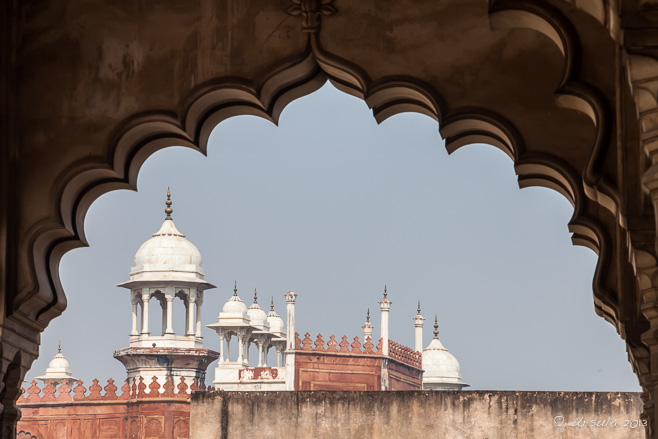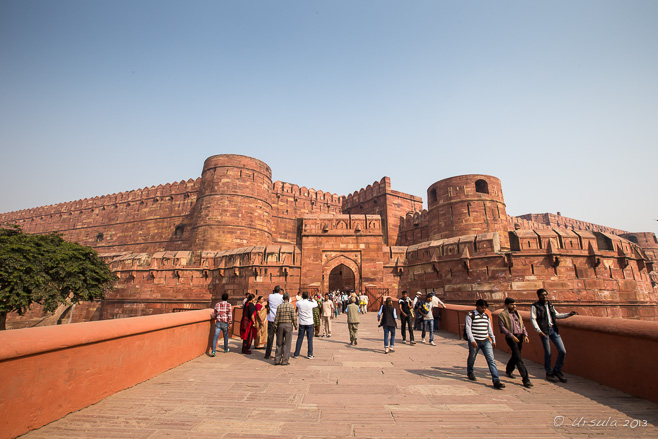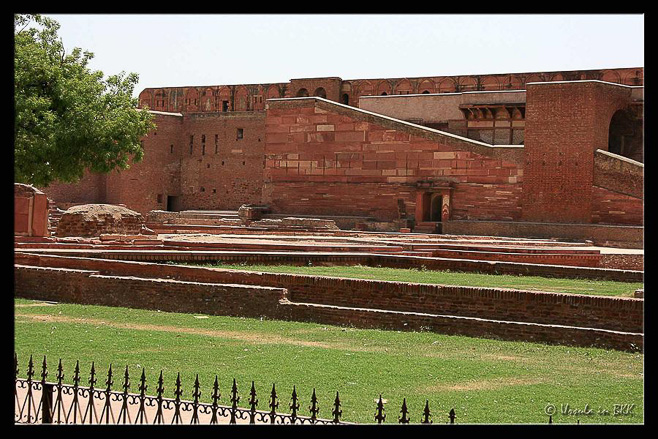
Inside Agra’s Red Fort
Built by Akbar the Great in red sandstone, and expanded and renovated in white marble by Shah Jahan, Agra’s Red Fort is a testament to Mughal architecture.
Agra, in Uttar Pradesh, northern India, is more than just the home of the Tāj Mahal. Once the capital of the Mughal (Moghul) Empire, ruling over all of India from 1556 to 1658, Agra houses many splendid Mughal-era buildings, three of which – the legendary Tāj Mahal, the wonderful deserted city of Fatehpūr Sikrī, and the magnificent Agra Fort – are UNESCO World Heritage listed.
In its current form, Agra Fort – also known as Lal Qila, Fort Rouge and the Red Fort of Agra – was built by the Mughals, particularly Akbar, Jahangir and Shah Jahan, as a walled city. The 380,000 m2 (94-acre) fort, stretching along the Yamuna River and protected by seventy-foot high walls, once housed as many as five hundred buildings in Bengal and Gujarat styles. Some of these original structures were razed to make way for Shah Jahan’s glorious white marble palaces. Others were destroyed by the British between 1803 and 1862 to construct barracks. While only a few of the Mughal buildings have survived, they speak of a rich history and are well worth a visit.
I’ve visited the fort twice: in 2008, on a private trip with my husband, and in 2012 on a group photo-tour with photographer Karl Grobl and local guide, DV Singh.
I loved exploring it and its stories both times.

Amar Singh Gate
Tourists enter Agra Fort through the massive red sandstone Amar Singh Gate.

Agra Fort Walls (2008)

Visitors Photographing the Visitors
We all have our cameras at the ready as we enter Agra Fort.

Jahangiri Mahal (2008)
A blend of Hindu and Central Asian architecture, the Jahangiri Mahal held the apartments of the Rajput wives of Akbar the Great.

Hindu Art
In the 11th century, the ruling Hindu Sikarwar Rajputs had a brick fort here. Some of the treasures from that era are still housed on site.

Diwan-i-aam
Built by Shah Janan in 1628 to welcome kings and dignitaries, …

Diwan-i-aam
… the many-pillared Diwan-i-Am (Hall of Public Audience) allowed everyone a view of the throne.

Woman in the Diwan-i-aam

Red Roof Truss (2008)

Tomb of John Russell Colvin (2008)
Colvin, lieutenant-governor of the Northwest Provinces of India, died of cholera during the peak of the Indian Rebellion of 1857. His entombment in such a prominent location at Agra Fort, which was at that time a military garrison, is considered by many to be extremely culturally insensitive.

Three-Striped Palm Squirrel
One of the first thing I always notice in India is the wildlife: the birds in the skies and creatures on the ground.

Khas Mahal and the Anguri Garden (2008)
Agra Fort was a walled palatial city; a fortified royal residence. The Khas Mahal was built by Shah Jehan between 1631-40, for his two favourite daughters.

Musamman Burj
Also known as the Saman Burj or the Shah-burj, the Musamman Burj is an octagonal tower standing close to the Shah Jahan’s Hall of Private Audiences, the Diwan-e-Khas.

Mussaman Burj – Palace Rooms
The Musamman Burj is made of beautiful marble with (now dry) fountains, ornamental niches, and delicate lattices so that the ladies of the court could look out on the world without being seen. Water flowed through the walls to keep the rooms cool in the heat of the Indian summer.

Marble Beauty (Composite 2008)
The workmanship, in the inlaid marble (pietra dura inlay) in semi-precious stones throughout the the palace rooms, is stunning.

Palace Prison (2008)
Irony: Shah Jahan, who built large parts of Agra Fort – and who built the Taj Mahal for his beloved wife – was imprisoned by his third son Aurangzeb in the fort from 1658 – in rooms where he had a view of his wife’s mausoleum – until he died January 22, 1666.

The Taj over the Yamuna River Flat
From Agra Fort, the Taj Mahal is visible; less so these days through the haze and smog over the river.

Mother and Child
Most of the visitors to the fort are Indian; my travel companions and I are in the minority.

Inside Agra Fort
The delicate beauty of the Moti Masjid (Pearl Mosque) behind the Diwan-i-Am Courtyard.

Wall and Door

Gate Keeper (2008)

Mosaic on the Gate (2008)

Decoration …
In the old days, the sloped entries to the fort protected against attack by elephant… Today, barbed wire laces the perimeters.
 It was an amazing era, leaving behind a legacy of beautiful Indo-Islamic architecture that is a joy to behold and explore. One can easily get lost imagining the lives and loves lived within the city-palace walls.
It was an amazing era, leaving behind a legacy of beautiful Indo-Islamic architecture that is a joy to behold and explore. One can easily get lost imagining the lives and loves lived within the city-palace walls.
Namaste!
Pictures: 21April2008 and 17November2013



























.png)

